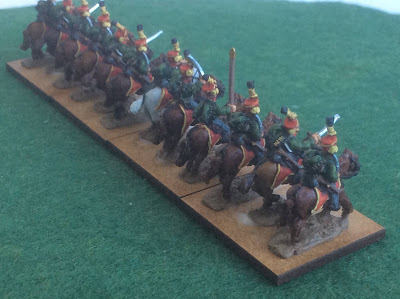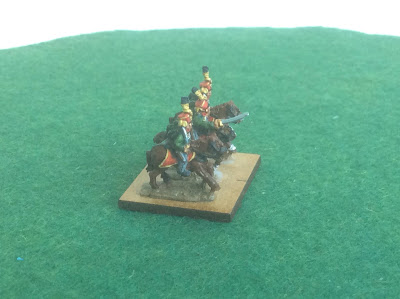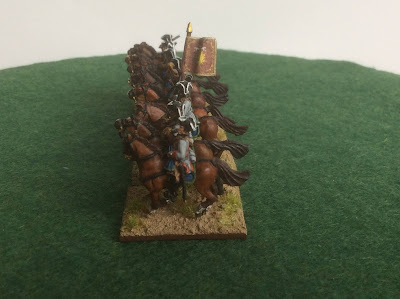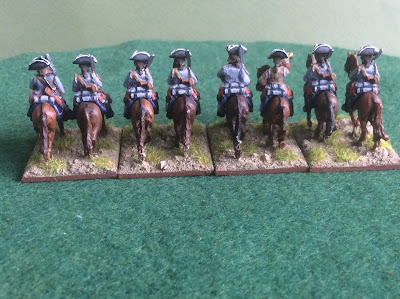Hunting through the pile of unpainted figures for something to work on, I came across some Wargames Foundry Canaanite chariots. I decided to paint up one of them and here it is.
Sunday, May 30
1809 Project (008) Ott Hussars completed
I finally got round to basing up Hussar Regiment No.5 Ott. There is one change from my original concept. The standard bearer has been left out and his place taken by another trooper. I wasn't happy with the standard. Size, colour and how it was affixed were all wrong. I knew it would bug me every time I saw it so it wasn't a difficult decision to drop it, especially as I had painted an extra trooper with the initial batch.
Wednesday, May 19
1809 Project (007) - WIP Hussar Regt No. 5 Ott
I was nervous about starting this unit, and as a consequence I put it off for a while and allowed myself to be distracted by other projects. However, I finally got down to looking at them and this is the progress so far.
This is Hussar Regiment No. 5 Ott, which formed part of VIII corps at the battle of Piave in 1809
The the most dsitinctive features of the uniform were a dark green dolman and pelisse with black fur trim, plus a red shako
Saturday, May 15
Scratching the 28mm Itch
After seeing some Avanpost Metal figures on Gavin Booth's You Tube channel I was motivated to try out painting some 28mm Napoleonics of my own again after several years break. To be completely accurate it was one figure - a Grenadier drummer of around 1809. It was quite an enjoyable little side project although these highly detail figures have a lot of bits to paint and can be fiddly.
1809 Project (006) - 2nd Battalion, Infantry Regt 61 St Julien
I finally finished painting and basing a second battalion of Hungarians for Archduke Johann's Army of Inner Austria. These are the 2nd Battalion of Infantry Regt 61 St Julien and were part of the Austrian VIII corps commanded by Albert Gyulai.
Friday, May 14
Minden 1759 Project (003) - Vogüé Cavalrie
The next French cavalry regiment is complete. This is Vogüé cavalrie. This leaves just 2 further regiments to complete. These are Blue Moon figures, with a bit of Green Stuff added, to give the troopers long coats with turnbacks.
Monday, May 3
Minden 1759 Project (002) - Condé-cavalerie
The latest addition to my 15mm Seven Years War French Army based on the Battle of Minden in 1759 is the 2 squadron regiment of Condé. These figures are Blue Moon Miniatures.
Monday, April 26
Minden 1759 Project (001) - La Rochefoucauld de Surgère Cavalerie
A 2 squadron regiment forming part of Fitzjames dvision at the Battle of Minden, 1759.
These are old 'Old Glory 15s' - seven of them are from the French cavalry pack plus one from which needed ahead swap, replacing a bearskin with a tricorn.
Wednesday, April 14
1809 Project (05) - The first Hungarian Battalion is complete
This is the 1st Btn of Infantry Regt 61 St Julien. 3 Battalions of this regiment formed part of Colleredo's brigade in the Austrian VIII Corps at the battle of the Piave in May 1809.
They have the distinctive sky blue trouers and this regiment had 'grass' green collar, cuffs and piping.
The flags are from Napflags and scaled for 10mm figures. That was a bit fiddlybut you only have to do it once.
For more information about the project check out the video on my You Tube channel
Thursday, April 8
1809 Project (04) - Hungarian Infantry Officers (Work in Progress)
This figure is modeled with small bag or bundle on his back. It's not clear what it is intended to represent. In the end I chose to paint it in the same grey I used for the rolled greatcoats on the rank and file figures. The 1st battalion is progressing and will be the next unit completed.
Update - the mysterious bundle has been identified as a pistol in a holster by a very kind contributor on the Pendraken Forum - Thank you John Cook
Friday, April 2
1809 Project (03) - First French Unit Complete
My first unit of Eugene's army in Italy in 1809 has been finished. This is the 1st Btn of the 102nd Line. This battalion and the 3 others from this regiment formed part of Grenier's division at the battle of Sacile and took part in most of the engagements that followed in Eugene's campaign to first drive the Austrians from Italy and then to take the army into Austria itself.
The 6 company organisation adopted by the French gave each line battalion 2 elite companies (of genadiers and Voltigeurs) and 4 centre or fusilier companies. I have used a 32 figure unit to represent this and in my set up the elite companies have 4 figures each while 3 of the fusilier companies have 6 figures. The 2nd fusilier company is represented as a single rank of 3 figures behind the command group of an officer, the eagle bearer and a drummer.
Friday, March 26
1809 Project (02) - 10mm Napoleonic French Infantry Test
Structuring my French battalions also proved to be a challenge. I am not going to worry about the theoretical difference in strength between the French, Austrian and Hungarian units. In my set up, line units are all going to be 32 figures. So a French battalion will consist of the following figures; 4 Grenadiers, 6 fusiliers with dk blue pompoms, 3 fusiliers with aurora pompoms with a'command' group of 3, then 6 fusiliers with violet pompoms, 6 fusiliers with crimson pompoms and finally 4 Voltigeurs.



















































